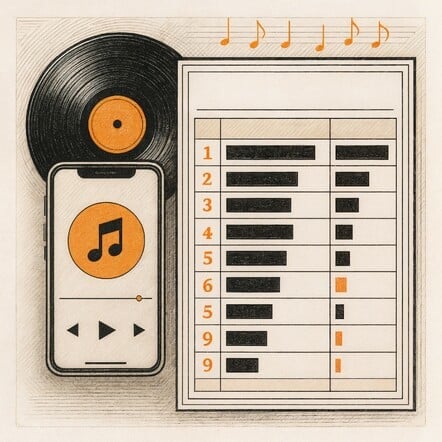New York, NY (Top40 Charts) Have you ever listened to a song on your favorite app and wondered how that single play contributes to its popularity?
For years, measuring a song's success came down to sales and radio plays. But today, things have taken a turn in a much more exciting and dynamic direction.
Thanks to streaming, how we define a hit has completely transformed. The rules have changed, and with them, the music world has opened up in some truly surprising ways.
Streaming platforms didn't just make listening easier, they also gave artists and fans a new way to connect and interact.
Suddenly, success wasn't just about what sold in stores or what played on the radio. Instead, it became about who was listening, how often, and what songs kept people coming back.
That shift has turned the industry into something far more flexible, accessible, and rewarding for artists of all levels.
From Physical Sales to Digital Plays
Back in the day, the charts were built on physical sales. CDs, cassettes, and vinyl drove the rankings, and those numbers told the story of a song's reach. As digital downloads came into play, the industry started to change, but it was still largely based on purchases.
Streaming introduced an entirely new concept of access instead of ownership. Instead of buying a single track or album, listeners could stream entire libraries instantly, often for free or as part of a subscription.
Real-Time Popularity and Momentum
One of the biggest things streaming brought to the table was the ability to watch a song rise in popularity as it happened. Unlike traditional methods that took time to gather and process, streaming platforms track data instantly.
This means a song released today could start charting tonight if enough people hit play. That kind of speed is something the music world never had before, and it's completely changed the game.
Playlists as a Launchpad
Another huge change streaming brought is the rise of curated playlists. Whether created by the Slot gacor platforms themselves or by users, these playlists can boost a song's visibility in ways that radio never could. A single placement on a popular playlist can expose a song to millions of potential listeners who may have never heard of the artist before.
Global Reach with Local Flavor
Streaming doesn't have borders. A song released in one country can become a hit in another without needing a traditional marketing push. This global reach is one of the most powerful parts of the streaming revolution.
Artists from anywhere can build fan bases worldwide, and listeners can explore sounds from places they might never visit. That kind of cultural exchange enriches music as a whole and gives listeners more choice than ever before.
At the same time, streaming platforms also highlight local trends. This balance between global and regional success allows songs to thrive in different contexts. A track might become a dance-floor favorite in one part of the world while becoming a road trip anthem somewhere else. All of this is visible through streaming stats, making the measurement of success more layered and meaningful.
Social Media and Fan Interaction
Streaming data also works hand-in-hand with social media. When a song starts gaining traction on a platform like TikTok or Instagram, that buzz often translates into more streams. Viral challenges, clips, and trends all feed into a song's momentum. The connection between music and social sharing is stronger than ever, and it gives fans an active role in a song's success story.
Artists now engage with fans in real-time, respond to feedback, and even tailor releases based on how people react online. This feedback loop is something completely unique to the streaming era. It turns listeners into participants, giving them a sense of ownership and involvement that helps drive a song's continued popularity.
Measuring Long-Term Impact
In the streaming age, it's not just about the debut week anymore. Some songs grow slowly, gaining more fans over time as people discover them through playlists, recommendations, or social media. This kind of slow-burning success wasn't always visible in older systems, but streaming allows it to be tracked and celebrated. Songs that may have flown under the radar at release can eventually become major hits.
This new way of measuring success rewards consistency and connection. It shows which songs have staying power, which albums keep drawing plays, and which artists continue to resonate with their audience over months or even years. This makes the definition of success more inclusive and enduring.
Flexibility for All Kinds of Artists
Streaming has made the music landscape more open. Artists no longer need a major label deal to reach a wide audience. With just a few uploads, they can be in the same space as the biggest names in the business. This levels the playing field and allows more voices to be heard, which means more kinds of music are getting the attention they deserve.
Independent artists especially benefit from this system. They can release music on their own terms, build direct relationships with fans, and watch their numbers grow in real time. They also have access to the same insights and data that major acts use. This kind of empowerment helps more artists find success in their own way.
Redefining What It Means to "Make It"
The music world used to have a very specific idea of success. It usually meant charting on the radio, selling out venues, or going platinum. While those things are still meaningful, streaming has introduced new ways to achieve recognition. A song might never top the charts but still reach millions of listeners across the world. That's a kind of success that reflects real impact and real connection.
Artists today are celebrated not just for big numbers, but for how deeply their music resonates. Some build niche followings that support them throughout their careers. Others find that one song keeps streaming year after year, long after it left the headlines. Streaming gives us all these stories and more, proving that there are many paths to musical success.
Final Thoughts
Streaming has turned the music industry into something more exciting, more immediate, and more inclusive. The way we measure a song's success has changed in the best possible way. Instead of just looking at sales or radio spins, we now get to see how often people are truly listening, sharing, and coming back to a song. It's a reflection of real connection, real enjoyment, and real-time discovery.
























